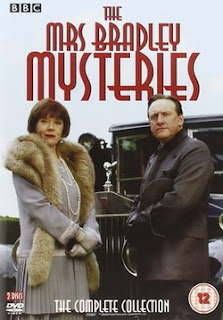Sleepy village provides interesting material for Freud follower Mrs Bradley
The Vicar’s
maid is strangled only a few days after giving birth to an illegitimate baby that
no one has ever seen in The Saltmarsh Murders, the fourth novel to feature the
psychoanalyst and amateur detective Mrs Beatrice Adela Lestrange Bradley.The Saltmarsh Murders was
the fourth Mrs Bradley mystery
Conveniently,
Mrs Bradley is staying at the Manor House in the village of Saltmarsh, as a
guest of the local squire and she is only too happy to lend a hand with the murder
inquiry.
As a professional
psychiatrist and follower of Freud, Mrs Bradley finds a wealth of interesting
cases in the village to test her theories on. She encounters a female resident who
believes everyone in the village is some kind of animal and meets the bizarre
inhabitants of a remote bungalow who have imprisoned their neighbour in the
crypt of the church.
The story
is told from the point of view of the young curate, Noel Wells, who lives at the vicarage and is in love with
Daphne, the Vicar’s niece.
Mrs Bradley
adopts Noel as her ‘Watson’, asking him to introduce her to some of the families
in the village and also to provide her with secretarial assistance.
Noel is
both terrified and fascinated by Mrs Bradley. He admires her brains and beautiful
voice, but he hates being prodded in the ribs by her yellowed talons and is
unnerved by her sinister cackle. Seeing Mrs Bradley through his eyes, when he
does not completely understand her theories or why she is behaving the way she
does, is amusing and also a clever device by Gladys Mitchell to keep the
mystery going until the end of the book.
Mrs Bradley’s
investigation uncovers a smuggling racket and involves a corpse going missing, the
vicar being locked up in the village pound
and an exhumation being ordered, before peace can be restored to the sleepy
village of Saltmarsh.Some of the Mrs Bradley novels
were adapted as a BBC TV series
The book reveals
a lot of interesting detail about life in England at the beginning of the
1930s. As a schoolteacher, Gladys is able to portray children and young people
very well and, as in her first three books, she uses them as main characters.
Gladys wrote 66 novels featuring her amateur
sleuth, Mrs Bradley, as well as mystery novels under the pen name Malcolm
Torrie, and historical adventure novels under the pen name Stephen Hockaby.
She got off the mark in 1929 with Speedy Death, which introduced Mrs Bradley, and she never looked back, writing at least one novel a year throughout her career and gradually building a large and loyal following for her eccentric but brilliant detective.
Gladys was an early member of The Detection Club along with Agatha Christie, G K Chesterton and Dorothy L Sayers, but frequently satirised or reversed the traditional patterns of the genre in her novels.
In 1961, Gladys retired from teaching but continued to write. She received the Crime Writers’ Association Silver Dagger in 1976.
The last Mrs Bradley mystery was published in 1984, the year after the author’s death in Corfe Mullen, a village in Dorset.
The Saltmarsh Murders by Gladys Mitchell was first published in 1932 but has been republished by Vintage Books and is now available as a paperback or Kindle edition.



